Happy Holidays: Boost eCommerce Sales With PPC 


Get ready for a cracker of a Christmas in 2018. ECommerce retail sales are set to grow by 15%-17% in 2018, according to Visa.
This is on top of a massive year in 2017. According to Nielsen, more adult Australians than ever took to online retailers and department stores for their Christmas shopping in December 2017.
We’re talking 14.4 million Australians.
That’s a serious revenue opportunity.
There’s just one teeny tiny problem: Amazon.
This online behemoth is preparing to ramp up its local online retail offer in Australia.
So, if you want a piece of the holiday pie, you need to plan a killer PPC strategy for ecommerce.
Lucky for you, this article will equip you with the best PPC strategy for ecommerce.
We’re not going to tell you how to set up your PPC from scratch – you can find that kind of technical ‘how-to’ info in our other articles.
What we want to share with you is how to hone your PPC and holiday marketing ideas to make every moment count throughout the festive season.
Armed with the practical knowledge you’ve picked up from our other articles (and from running your own campaigns) this strategic insight will help you capture as many tinsel dollars as possible during the weeks that matter most to ecommerce.
We’ve prepared our list and checked it twice – read on for the best holiday marketing strategies.
Watch what your competition is doing.
What are your competitors doing with their PPC strategy for ecommerce?
Keep tabs on the competition and spy on the keywords they’re targeting during the holidays.
One of the easiest ways to do this is using SEMrush.
SEMrush is a competitive intelligence suite that shows you what keywords your competitors are ranking for.
Do you know one of the best things about SEMrush?
It reveals the low-hanging fruit keywords that you can scoop up and use to think of new keywords you may not have on your “nice” list.
Here’s how to get started:
See the keywords your competitors are bidding on. On SEMrush, all you need to do is enter your competitor’s domain in the Ad History report and it will show you their keywords and ads for the past 12 months.
Use this to sharpen your target list.
As an example, SEMrush looked at potential competitors of bicyclewarehouse.com. Here’s the Ads History report for one of the competitors:
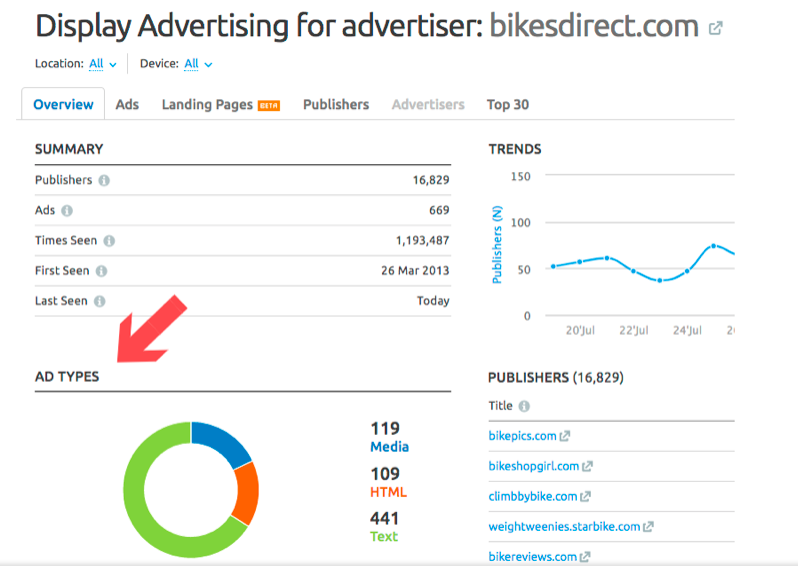
Then, analyse the data to work out how cost-efficient a certain keyword could be for your ecommerce business.
Find the gaps in your competitor’s strategy and attack them with your holiday campaign. Head to the Keyword Gap tool and enter up to five competing domains (including your own) to compare similarities and differences. Which keywords are your competition ranking for that you don’t?
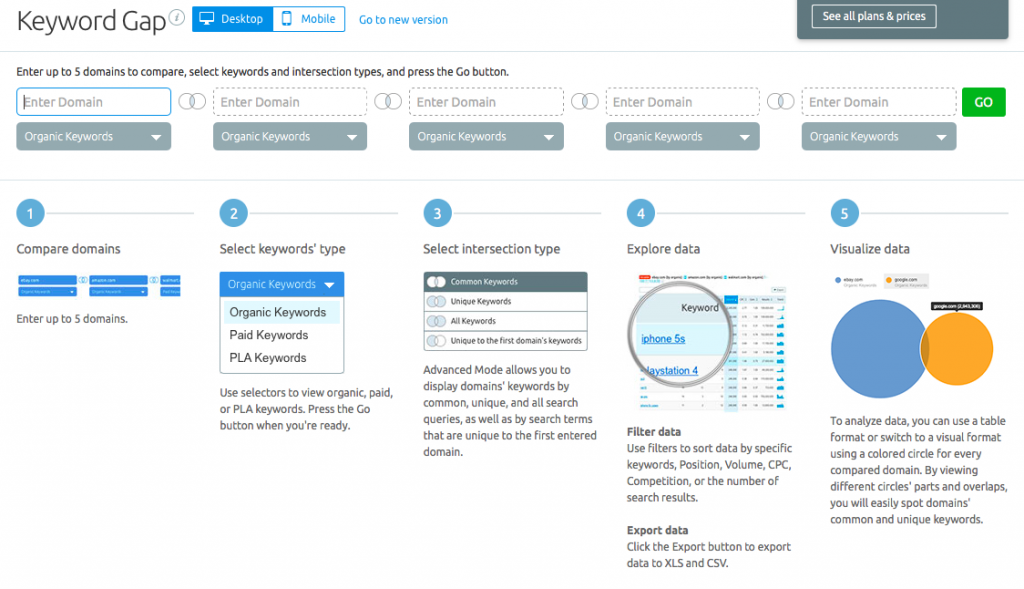
Don’t stop at Google AdWords for ecommerce – organic keywords can spark some winning holiday marketing ideas too!
Finally, look at what your competitors emphasise in their holiday ads. Are they spruiking free shipping? Holiday gift packs? Discounts?
Take a look at these three different examples for the search term “hamper gift”:
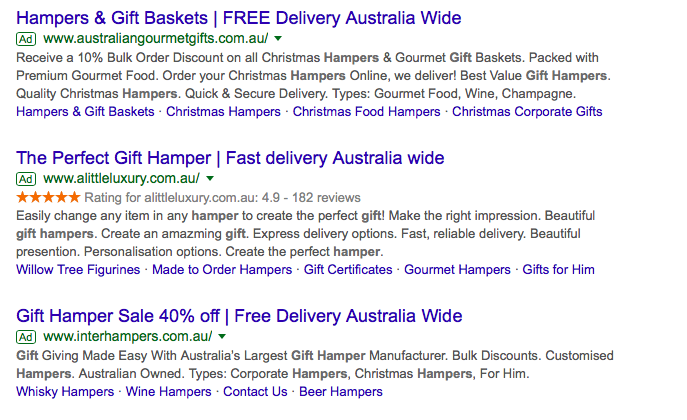
All of this can be done using SEMrush tools, but there are plenty of other competitor research tools you can use, including:
- AdWords Auction Insight Tool– Free tool located directly in your AdWords account. Great for a quick glance but does not show actual ads.
- AdWords Preview & Diagnostic Tool– Use this to spy on competitor’s ad copy in various geographic regions.
Double down on remarketing.
Google ad retargeting is already a powerful tactic for ecommerce.
Remarketing ads are proven to have much higher click-through rates and conversion rates than typical display ads
The team at Wordstream have done some pretty thorough research on this – check it out.
The power of remarketing is supercharged during the holidays.
Here’s why:
People are going to be searching the web in a desperate effort to find gifts, while trying to remember their niece’s favourite Disney character and trying to avoid an inappropriate Secret Santa pressie.
Thanks to your winning Adwords advertising, they will arrive at your website.
They might put something in the shopping cart, but in a frenzy to get their holiday shopping done, they’ll click around and forget exactly which site it was they saw that perfect gift.
Sound familiar? That’s because this is a typical Christmas shopping experience.
Now, if you invest in retargeting, you can make sure that gift pops up as a reminder when they visit other sites – complete with an irresistible offer:

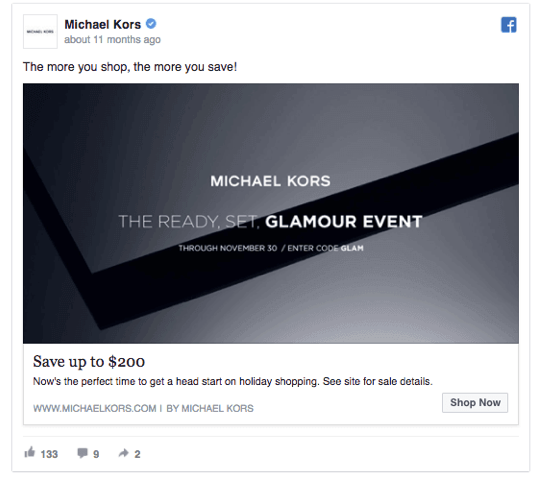
But it gets better. If the customer abandoned their shopping cart, your retargeting campaign can be set to remind them to come back and complete the purchase. We love this awesome example from RedBalloon:
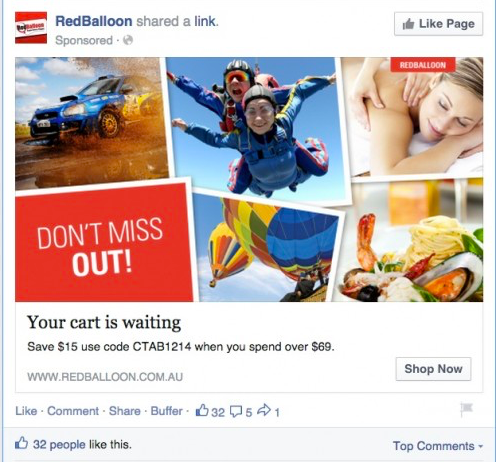
There’s so much that’s right about this ad. Note the special discount code to entice the shopper back to complete the purchase and the strong CTA button “Shop Now”.
Why is retargeting so successful? Because you’re marketing to people who’ve already shown an interest in what you have to offer. They are more qualified leads. This means cost per click (CPC) will be lower, conversions will be higher, and better return on investment is within your grasp.
For successful holiday marketing, you need to utilise remarketing lists early.
November and December are key for retargeting as you can reach those panicky last-minute shoppers and re-engage those high-intent shoppers who didn’t complete a purchase.
If you are already running retargeting campaigns, double your efforts as part of your holiday marketing campaigns.
Use a low bid at the beginning of the holiday season to begin building product awareness. When the holidays rev into high gear (think December), adjust your bids based on past behavioural patterns.
Pro Holiday Tip: If you typically allow users to be added to your remarketing list for 30 days, reduce that to as little as 7 days . That will increase the chances of the individual seeing your ads more frequently in the countdown to Christmas.
Ramp up your Google Shopping Ads.
A staggering 9.3 million Australians took to their smartphones to shop for Christmas 2017, according to Nielsen.
Why does this matter?
Because the presence of Google Shopping Ads (aka Product Listing Ads) at the top of the page squeezes out organic results on small screens.
Here’s what happens when I search “Buy camera online” on my mobile:
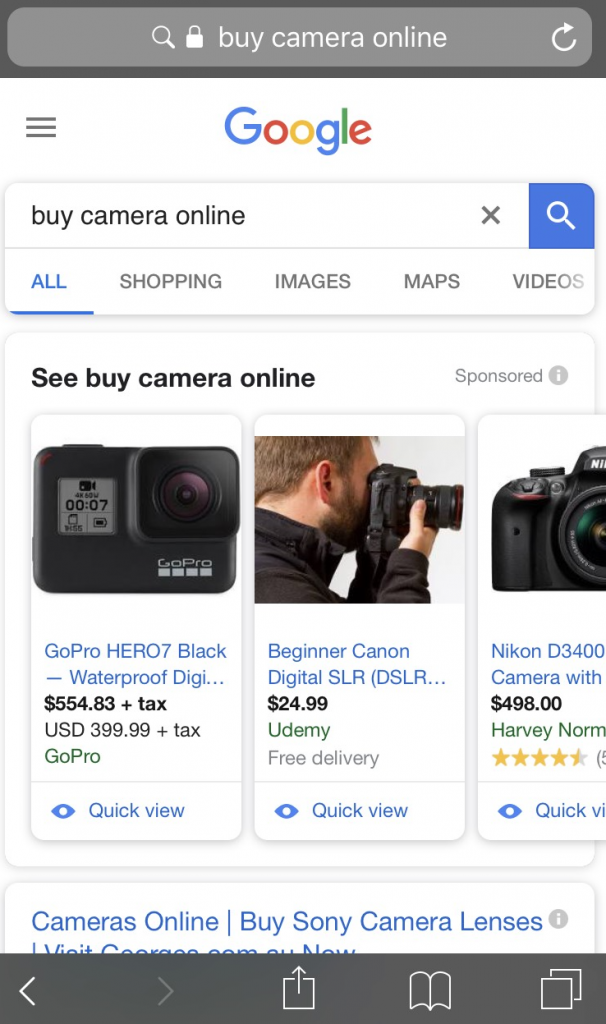
And here’s what I see on my desktop for the same search:
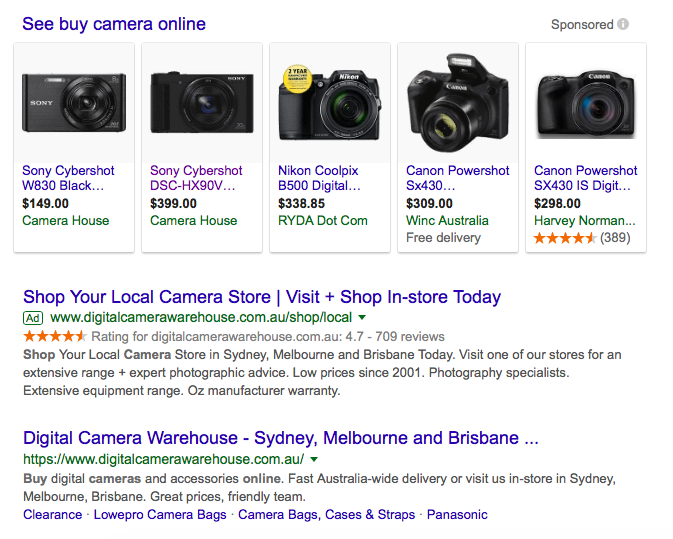
Bottom line: if competitors are up there and you’re not, you’ll wind up losing out on all those holiday dollars.
No matter what other amazing Christmas marketing ideas you might have up your sleeve.
And if the stats are anything to go by, your competitors are already up there: A study by Searchmetrics shows that Google Shopping Ads account for 80% of all search spend.
The same study revealed that this percentage of search spend generated more than 85% of all clicks.
Can you afford to miss out?
No – that’s why you need to focus on getting your Google Shopping Ads ready.
There are a few simple things you can do:
- Start by getting your product feed in shape. Make sure your product data is formatted to Google’s specifications and submitted to Google Merchant Centre.
- Optimise titles and descriptions. Place your most important keywords at the front end of the title and description.
- Watch product disapprovals. Go to the diagnostics tab in the Google Merchant Centre. This is what you might see:
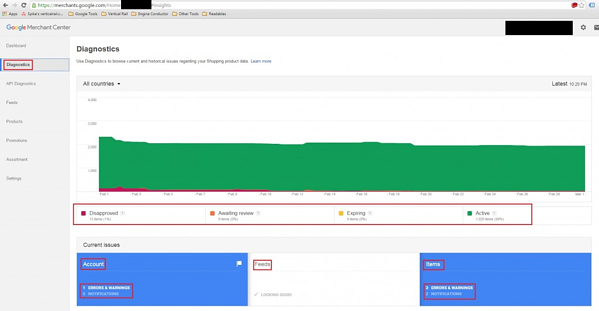
Image source: https://www.verticalrail.com/kb/introduction-to-google-merchant-center-disapprovals/
Fix any disapprovals so your products are visible in shopping results.
- Set up daily reports to stay on top of any warning, issues or errors. Every day of holiday shopping has the potential for huge sales. Don’t lose out because you missed an easy-fix error.
- Choose epic product images. The image can make or break your campaign. It is the first thing the customer sees and the largest part of the ad. So, make sure all your product images are high quality and relevant. Remove anything that might be obscuring the view of your products, such as promo text.
Compare these two hamper images:


Both hamper companies chose great images. They show off the products brilliantly and look like high quality brands.
But the top image does things a little differently. The brand has chosen to lay out the products and add a festive (yet simple) red ribbon image.
The result? The red and green catches your eye and screams “Christmas hamper!” without being over the top.
How can you make your products stand out in a competitive market?
Time to get your bidding strategy right.
Prepare to face some stiff competition. But there are ways you can outdo even the biggest retailers (that means you, Amazon.)
- Bid at the SKU level. Focus on your top performing products and spend less on those that are struggling to bring in sales.
- Start with mobile ads before adding desktop shopping ads to find the optimal placement for you.
- Add negative keywords to each of your product groups to control when your ads are not shown.
- Use remarketing lists for your shopping campaigns too. This allows you to customise bids to previous visitor audiences, such as shopping cart abandoners, returning visitors and previous customers.
Pro Holiday Tip: Brush up on Google Shopping policies to avoid potential hurdles along the way. The last thing you need is the extra stress of product disapprovals or customers trying to purchase gifts that are out of stock!
Spice up your seasonal AdWords
If you haven’t already started working on your seasonal Google AdWords, what are you waiting for?
Google’s Retail Academy 2017 reported that for every search on a retailer there are three searches on products.
The reason is because shoppers aren’t certain about the specific brand they want to buy when they first start looking for information online. That’s where Google AdWords for ecommerce are important.
Here are a few holiday marketing strategies we use for our ecommerce clients:
-
-
- Creating sense of urgency
- Give them a deal they cannot pass up
- Bid when your shoppers are searching
- Use seasonal ad copy that’s action-oriented.
-
And they work!
Let’s look at each tactic in more detail.
1. Create a sense of urgency.
Compel your target audience to click on your ads with limited time offers. This might be limited stock or a discount available for this week only. Anything you can do to make them click today means they won’t go to your competitors tomorrow.
2. Give them a deal they cannot pass up.
Christmas shoppers are looking for deal, so your best chance of winning clicks is to create a special holiday deal that’s too good to pass up. Include coupon codes in your ad text, free gift wrapping, guaranteed delivery days and free shipping. In a time of heavy competition, this can give shoppers the final push through the checkout.
3. Bid when your shoppers are searching.
Set up ad scheduling to bid on the times when your shoppers are most likely to be searching. Hint: you’ve got to be competitive with your bids on the weekends.
4. Use seasonal ad copy that’s action-oriented.
Highlight your holiday sales by creating a new batch of ads with seasonal ad copy. Creating a custom landing page for a specific offer is also essential to increasing conversions. Don’t be afraid to have some fun with your ad text – just be sure to stay within Google’s text ad policy guidelines. For ecommerce, this is your chance to emphasise the warm and fuzzy spirit of the season, together with the advantage of avoiding crowded stores by shopping online:
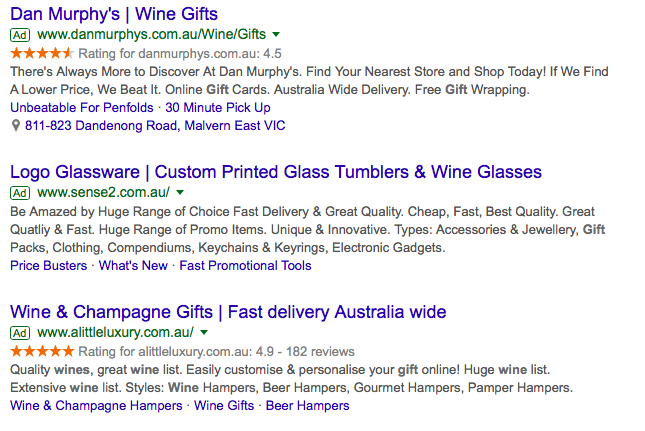
Notice how each of the advertisers above has taken a different approach with their ad copy.
Pro Holiday Tip: Set up conversion and revenue tracking in both Analytics and AdWords so you can accurately monitor performance of your Adwords campaigns. This is a must-have for any PPC strategy for ecommerce as it will help you see where and when to make gradual adjustments based on conversion data.
Let’s wrap it up.
As an ecommerce marketer, you can’t help but be excited (and maybe a bit nervous) for the holiday season. Paid search is set to be a winner for ecommerce this Christmas, but there’s some big competition out there. Follow our tips and you will execute a winning PPC strategy for ecommerce these holidays.
Before you start, be sure to check your list twice:
- Keep an eye on what your competition is doing
- Double down on remarketing
- Ramp up your Google Shopping Ads
- Spice up your seasonal AdWords
Even Santa has helpers, so if you need some PPC elves to power up your ecommerce strategy, get in touch with our team and schedule your free digital audit.
Your free digital audit will help you skyrocket sales. There’s no risk, no obligation, and no hidden fees. Think of it as our festive gift to you. Sign up below and we’ll have one of our experts get in touch.









